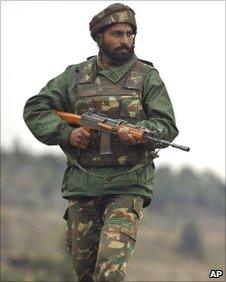India to deploy 36,000 extra troops on Chinese border
- Published

India says that it needs to strengthen its defences against China
India has formed two new army divisions - comprising more than 36,000 men - to defend the north-eastern state of Arunachal Pradesh.
The remote north-eastern state adjoins China which claims large parts of it.
The 56th Division will be based in the nearby state of Nagaland to guard the eastern flank of Arunachal Pradesh from Chinese attack through Burma.
The other new formation, the 71st Division, will be based in Assam to protect central Arunachal Pradesh.
There has been no response so far from China to the decision.
Mountain warfare
Already the Indian Fifth Mountain Division guards western Arunachal Pradesh while another division is responsible for protecting the eastern part of the state.
In addition there are counter-insurgency troops in Assam who can be sent to the Sino-Indian border at short notice.
A total of 1,260 officers and 35,011 soldiers have been assigned to the two new divisions, which are being especially equipped for mountain warfare.
Officials say they were formed at the behest of the Indian army chief, General VK Singh - who said they were necessary to beef up defences against China.

Gen Singh was not available for comment but one of his staff officers, on condition of anonymity, told the BBC that the army chief had "pushed very hard to fast-track the raising of the two divisions".
He said that they should be "fully operational" by March 2011.
He said their formation was India's response to the "huge Chinese build-up" in Tibet over the last three to four years. But he did not wish to elaborate.
India is also raising a paramilitary force called the Arunachal Scouts and Sikkim Scouts to help the army protect the Sino-Indian border in the states of Arunachal Pradesh and Sikkim.
"All the men in these formations will be drawn from mountain-fit local tribesmen but the officers will be from the army, at least for a while," said a corps commander.
Their formation will be modelled on the Ladakh Scouts, who the army says bravely fought Pakistani intruders during the Kargil conflict of 1999.
India says the new measures have been put in place partly because China has "superb" communications on its side of the border, especially after a new train line to Lhasa was built in 2006.
India says that the Chinese airlift capability is also far superior.
The formation of the two new divisions means that India's deployments in the eastern sector of its border with China now matches the five army divisions that existed in 1986-87, when the two countries nearly went to war.
But after India and China signed a "Peace and Tranquillity" treaty in 1993, both sides scaled down their deployments as part of a confidence-building package.